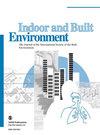Thermal comfort and indoor air quality in hospitals in the subtropics: Analysis of operating rooms and waiting rooms conditions
IF 2.9
3区 工程技术
Q2 CONSTRUCTION & BUILDING TECHNOLOGY
引用次数: 0
Abstract
The indoor air quality should provide adequate temperature and humidity levels, free from harmful pollution concentration. Proper heating, ventilation and air-conditioning (HVAC) system management is crucial in hospitals to prevent transmission of contaminated air and diseases. To verify whether healthcare facilities meet standard criteria for thermal comfort and indoor air quality, a field investigation in waiting and operating rooms was conducted in six hospitals in Brazil, in the summer. Thermal comfort parameters, carbon dioxide (CO2) concentration and differential air pressure were collected in loco. The results demonstrated that CO2 concentration was over 1,000 ppm in four waiting rooms, and no positive pressure was guaranteed in the operating room. The medical staff showed different thermal sensation variations in zone 1 (around the operating table) and zone 2 (remaining space around zone 1). In conclusion, most operating rooms had significant contamination risks and did not provide thermal comfort conditions to occupants. Due to improper HVAC design or high occupational density, air change rates were insufficient to guarantee adequate air renewal in the waiting rooms. There is an opportunity to improve the operation and maintenance process to provide healthy and comfortable environments in healthcare facilities, reducing nosocomial infections, especially during pandemic times.亚热带地区医院的热舒适度和室内空气质量:手术室和候诊室条件分析
室内空气质量应提供足够的温度和湿度,不含有害的污染浓度。适当的供暖、通风和空调(HVAC)系统管理对于医院防止污染空气和疾病传播至关重要。为了验证医疗设施是否符合热舒适度和室内空气质量的标准,我们在夏季对巴西的六家医院的候诊室和手术室进行了实地调查。现场收集了热舒适度参数、二氧化碳(CO2)浓度和气压差。结果表明,四间候诊室的二氧化碳浓度超过了 1,000 ppm,手术室没有保证正压。医务人员在 1 区(手术台周围)和 2 区(1 区周围的剩余空间)表现出不同的热感变化。总之,大多数手术室都存在严重的污染风险,无法为使用者提供热舒适条件。由于暖通空调设计不当或人员密度过高,换气率不足以保证候诊室有足够的空气更新。我们有机会改进运行和维护流程,为医疗机构提供健康舒适的环境,减少院内感染,尤其是在大流行病时期。
本文章由计算机程序翻译,如有差异,请以英文原文为准。
求助全文
约1分钟内获得全文
求助全文
来源期刊

Indoor and Built Environment
环境科学-工程:环境
CiteScore
6.40
自引率
25.00%
发文量
130
审稿时长
2.6 months
期刊介绍:
Indoor and Built Environment publishes reports on any topic pertaining to the quality of the indoor and built environment, and how these might effect the health, performance, efficiency and comfort of persons living or working there. Topics range from urban infrastructure, design of buildings, and materials used to laboratory studies including building airflow simulations and health effects. This journal is a member of the Committee on Publication Ethics (COPE).
 求助内容:
求助内容: 应助结果提醒方式:
应助结果提醒方式:


